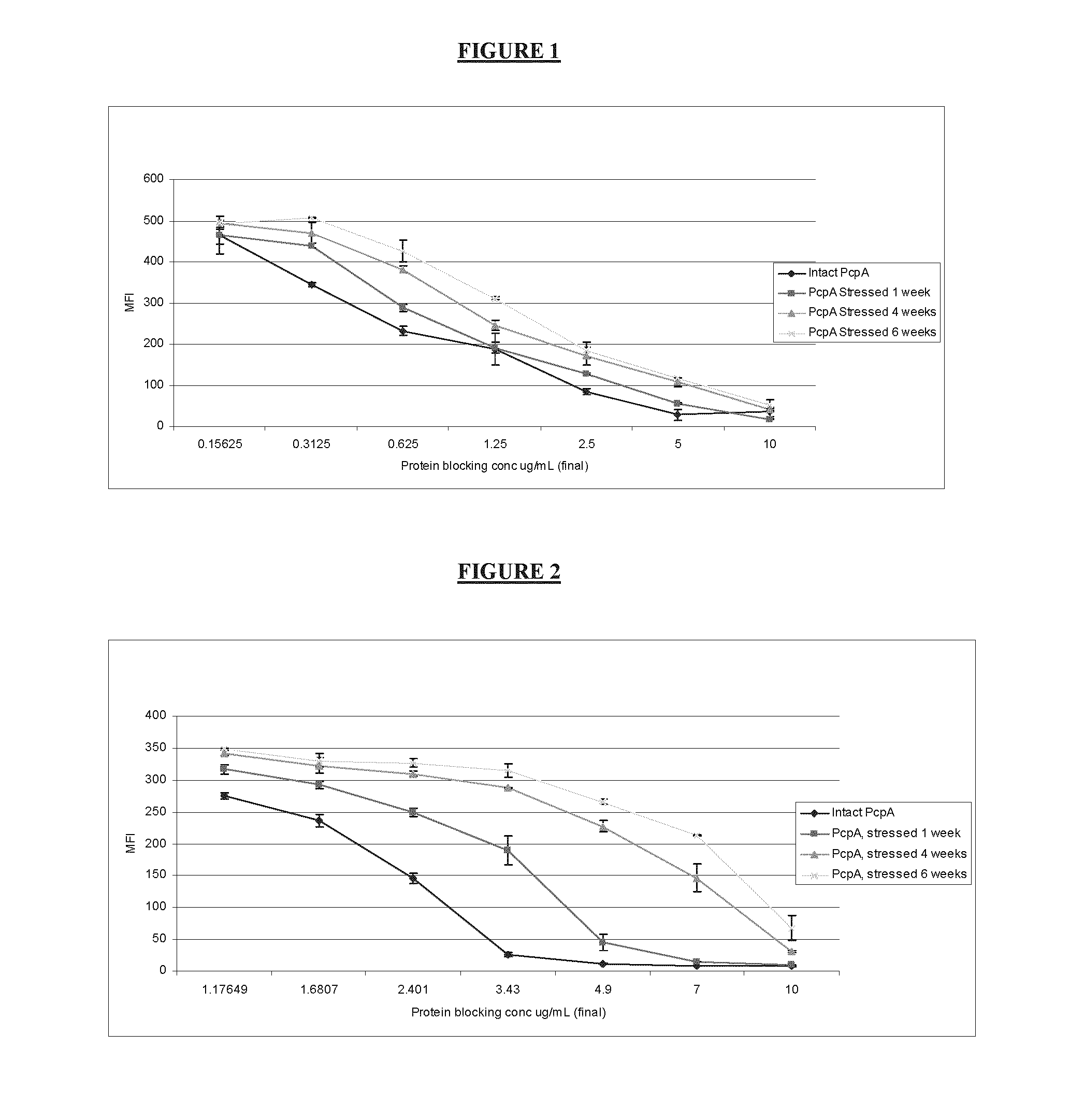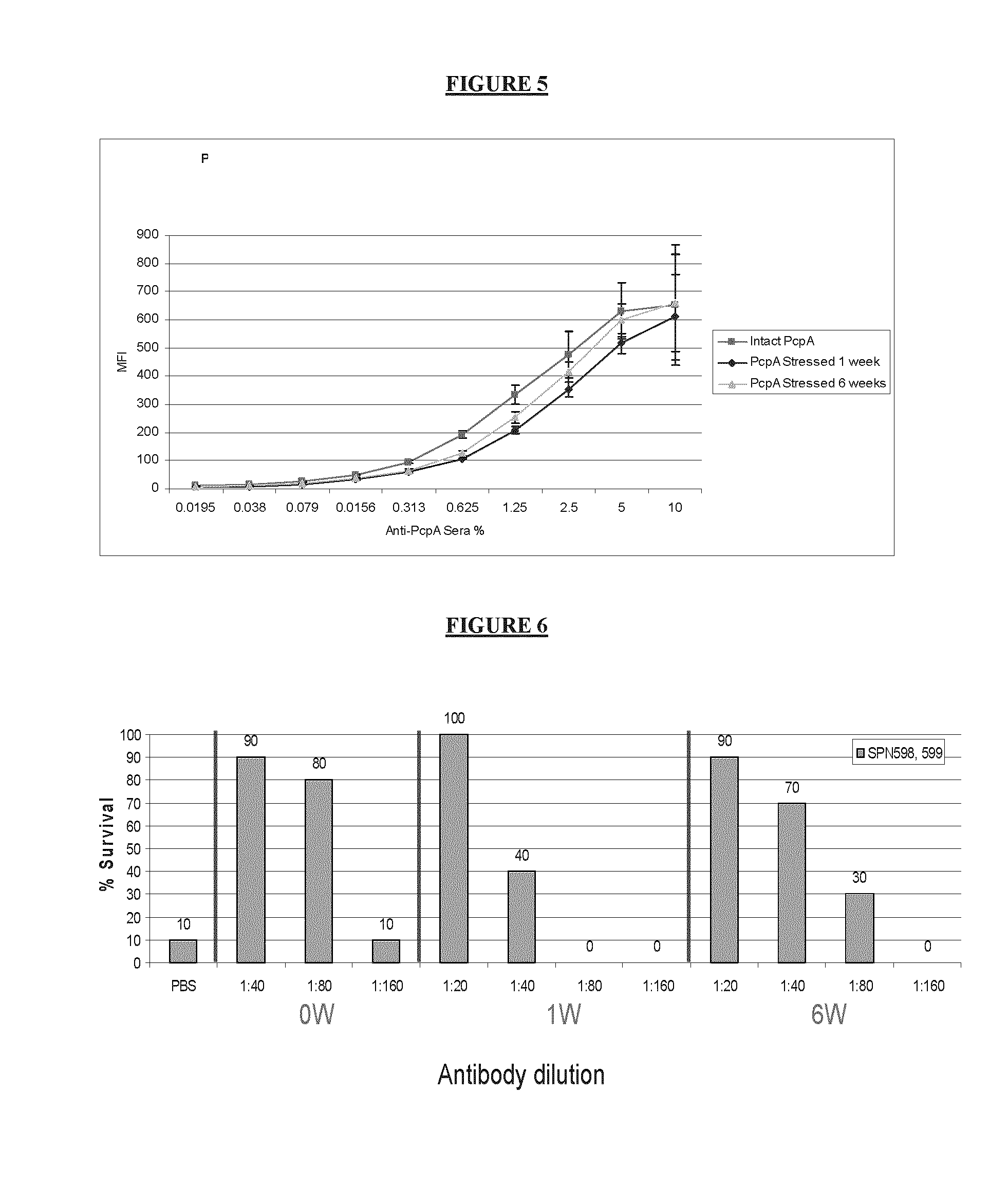Methods for assessing immunogenicity
a technology of immunogenicity and methods, applied in the field of methods for assessing immunogenicity, can solve the problems of difficult identification of protective vaccines, difficult ascertaining the quality of such drug products,
- Summary
- Abstract
- Description
- Claims
- Application Information
AI Technical Summary
Benefits of technology
Problems solved by technology
Method used
Image
Examples
example 1
Materials and Methods
[0038]The protein content and the antigenicity of samples either stored at 2-8° C. or stressed at 43-47° C. for 1, 4, or 6 weeks were tested by HPLC, ELISA and Biacore. The HPLC results indicated that monovalent PcpA protein content dropped by 20% following storage at 43-47° C. for 1 week and 40% following 4 weeks storage as compared to time 0. For both the ELISA and Biacore, two tests were performed upon the receipt of the samples and 5 months later to monitor their stability at 2-8° C. following the initial accelerated degradation procedure. Both tests performed within a 5 month period have shown that the protein stored at 2-8° C. does not undergo further degradation. ELISA, using protective monoclonal antibody 2B3, was able to detect a 50% drop in antigenicity following 1 week of storage and an 80-85% drop following either 4 or 6 weeks storage at 43-47° C. In contrast, Biacore (which utilizes polyclonal sera) indicates a 27% drop in antigenicity at 1 week and...
example 2
In Vitro Competitive SASSY
[0041]A. Competitive SASSY using anti-PcpA Polyclonal Sera or Monoclonal Antibodies to Test Intact or Stressed Formulations
[0042]The protein formulations as described above were used in a competitive SASSY with either polyclonal sera or monoclonal antibodies that include 2B3. FIG. 1 represents intact or degraded PcpA competing with A66.1 bacterial strain for binding to polyclonal sera. As expected intact PcpA protein was able to bind the polyclonal sera with lower amount of protein compared to protein stored at 1 or 4 or 6 weeks indicating that all the antigenic PcpA epitopes are accessible and intact in the pre-degradation step. On the other hand, through degradation of the protein, the epitopes bind less efficiently to the polyclonal sera and as a consequence a higher binding to the bacteria is detected. In order to measure their relative potency to intact protein, the area under the curve for each test sample was calculated and the inverse ratio to the i...
example 3
Correlation Between SASSY and Passive Protection
[0048]Correlation between SASSY and Passive Protection using Polyclonal Sera from Rabbit Immunized with Intact versus Degraded monovalant PcpA Formulations
[0049]A study was conducted to evaluate the relation of the competitive SASSY and antigenicity results to the actual biological effect of degraded proteins in animals Rabbits were immunized IM with either intact or degraded protein as described above and sera was collected following two boosts and used for IgG determination, SASSY and passive protection. While no significant differences were detected in the PcpA formulations treated for 6 weeks at 43-47° C., rabbits immunized with PcpA degraded protein for one week showed a 2 fold drop in anti-PcpA antibody titer and a 4 fold drop in passive protection. In order to verify whether the SASSY assay can detect these qualitative differences the same sera was also tested for their binding to A66.1 in SASSY assay. Results have also indicate...
PUM
| Property | Measurement | Unit |
|---|---|---|
| Time | aaaaa | aaaaa |
| Conformational barrier | aaaaa | aaaaa |
| Surface | aaaaa | aaaaa |
Abstract
Description
Claims
Application Information
 Login to View More
Login to View More - R&D
- Intellectual Property
- Life Sciences
- Materials
- Tech Scout
- Unparalleled Data Quality
- Higher Quality Content
- 60% Fewer Hallucinations
Browse by: Latest US Patents, China's latest patents, Technical Efficacy Thesaurus, Application Domain, Technology Topic, Popular Technical Reports.
© 2025 PatSnap. All rights reserved.Legal|Privacy policy|Modern Slavery Act Transparency Statement|Sitemap|About US| Contact US: help@patsnap.com



